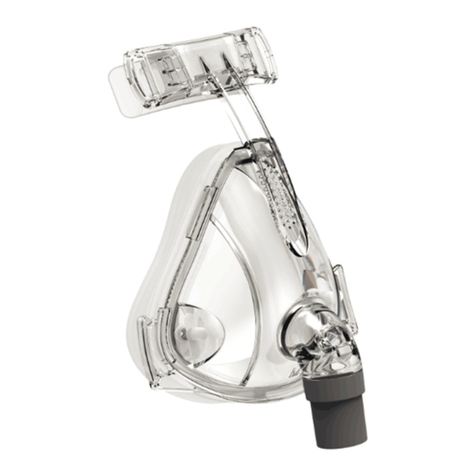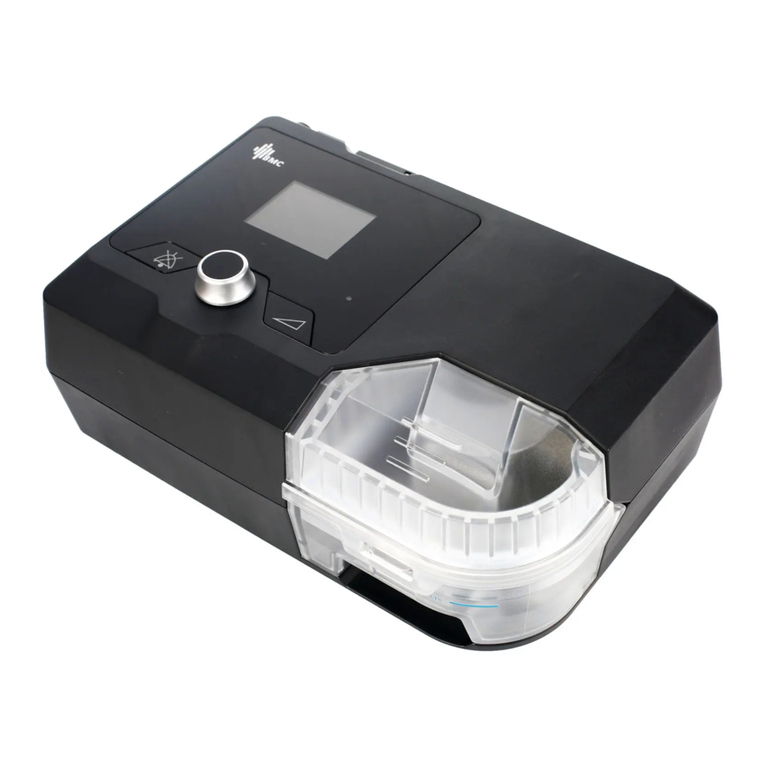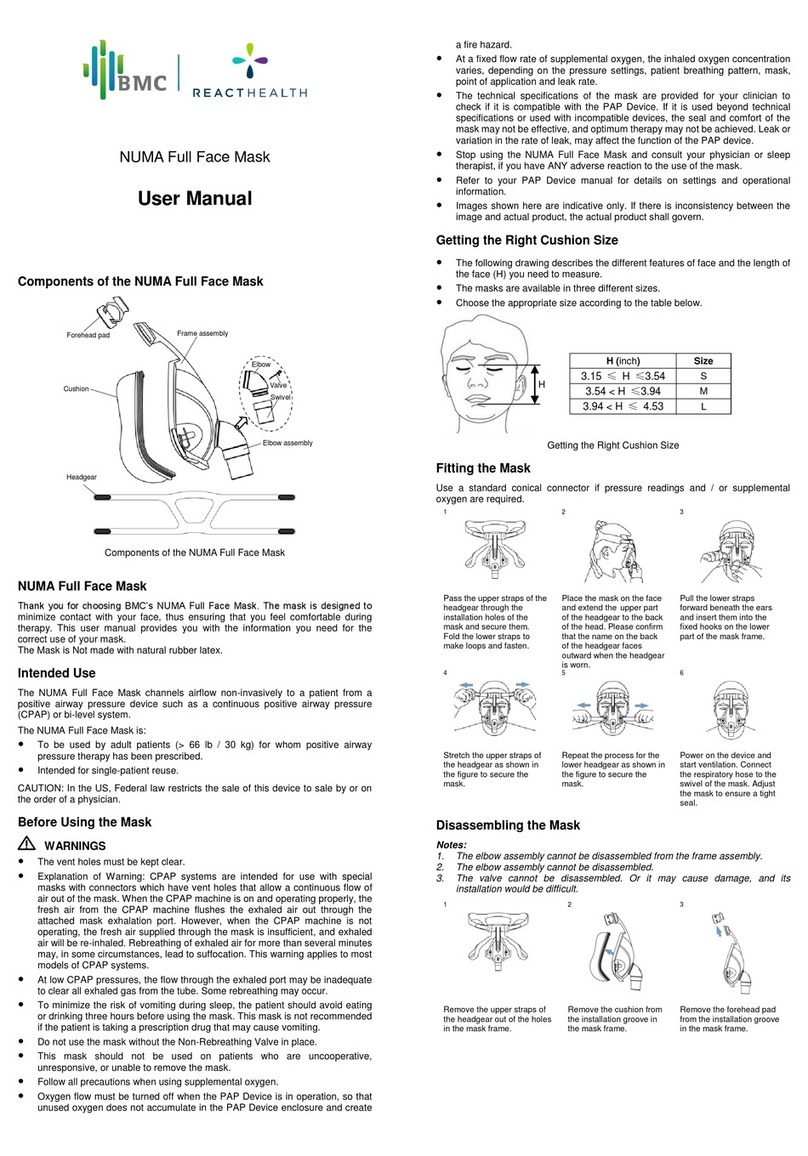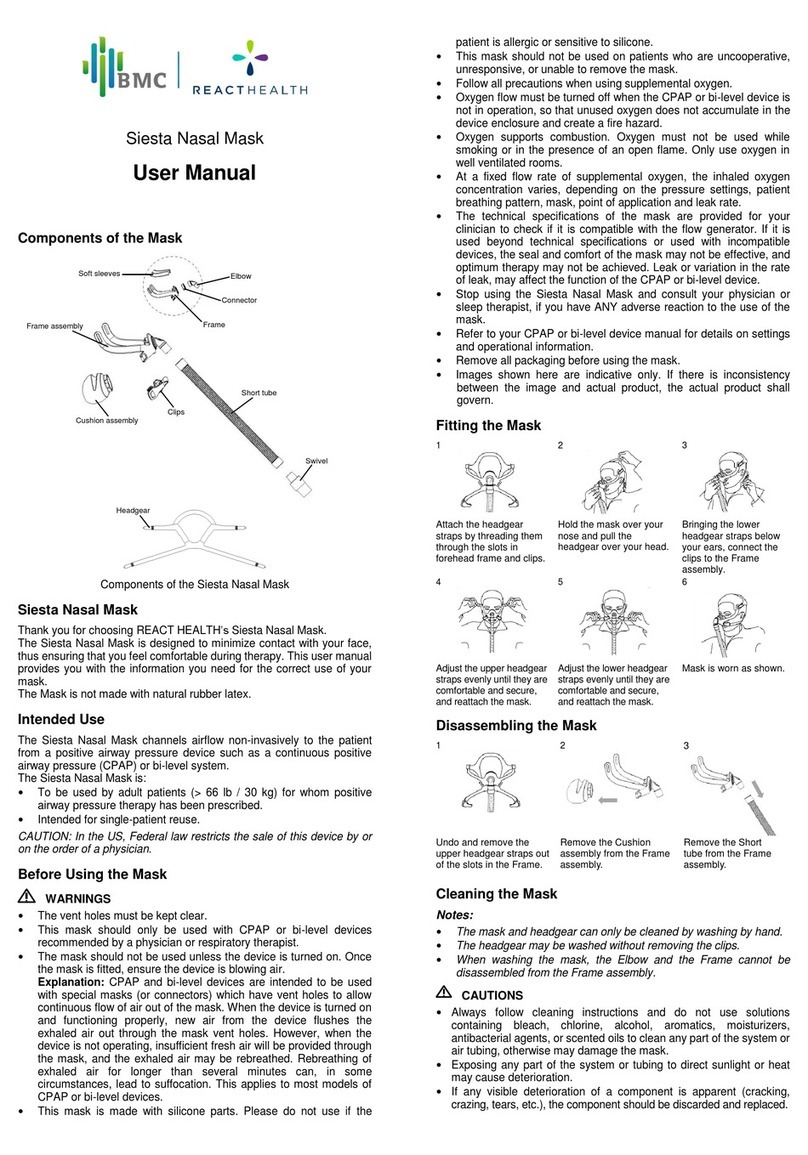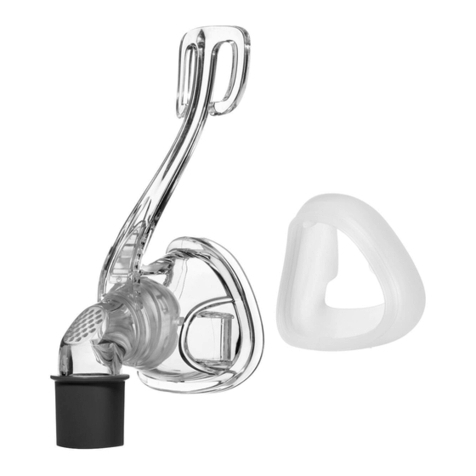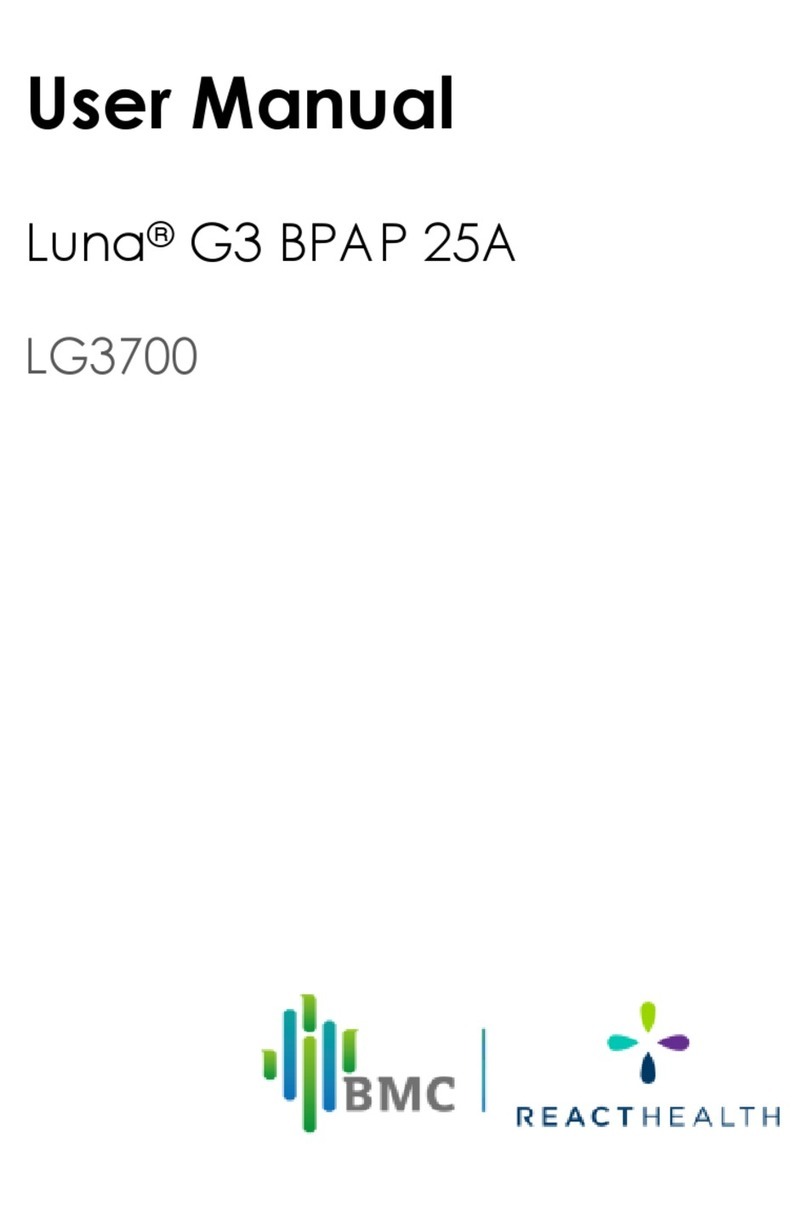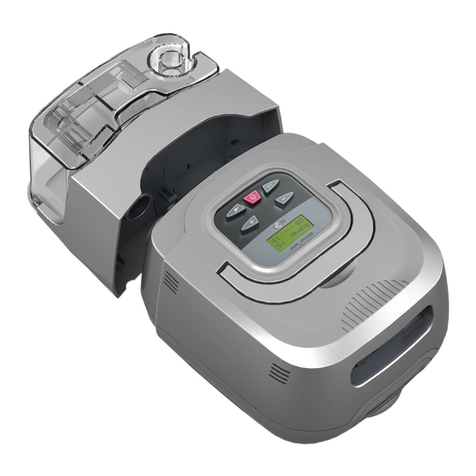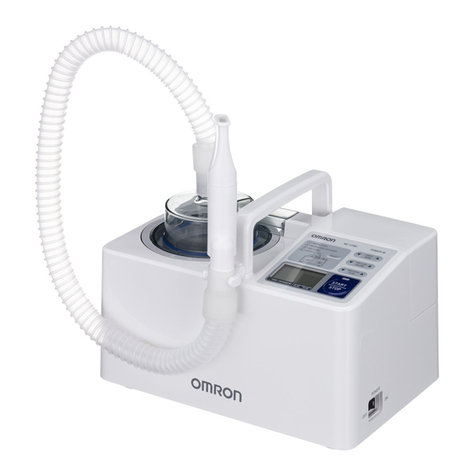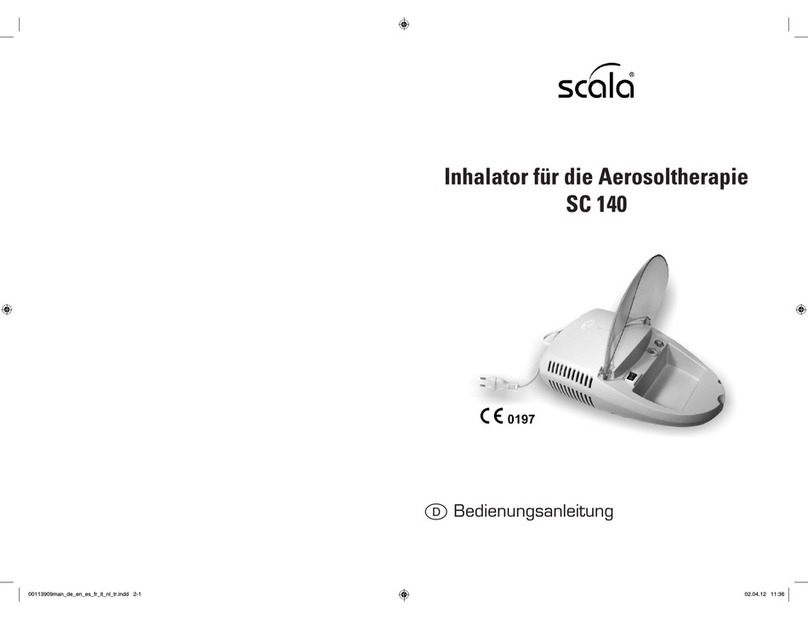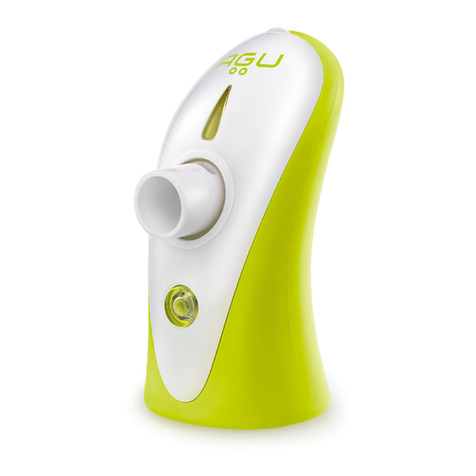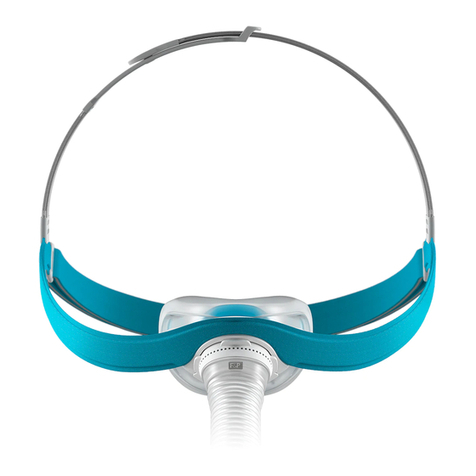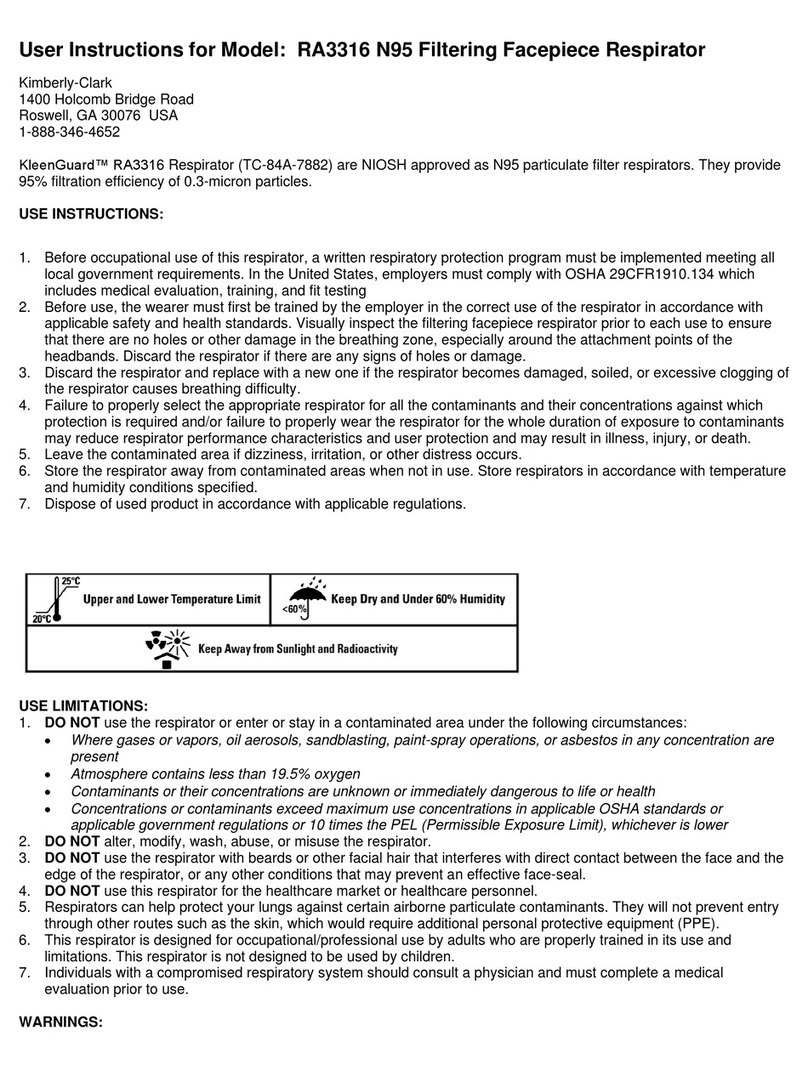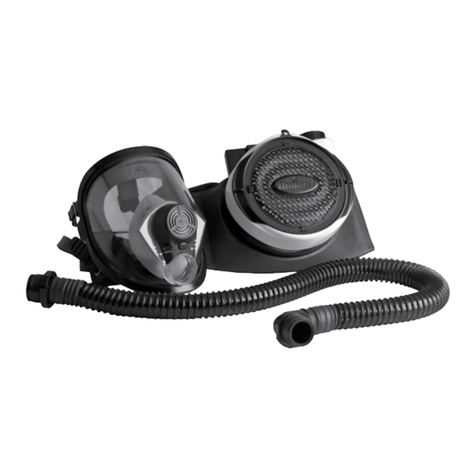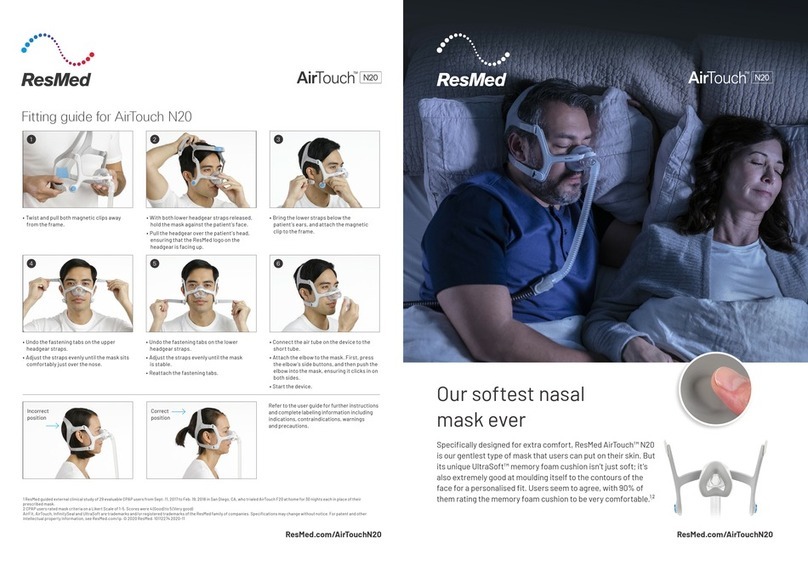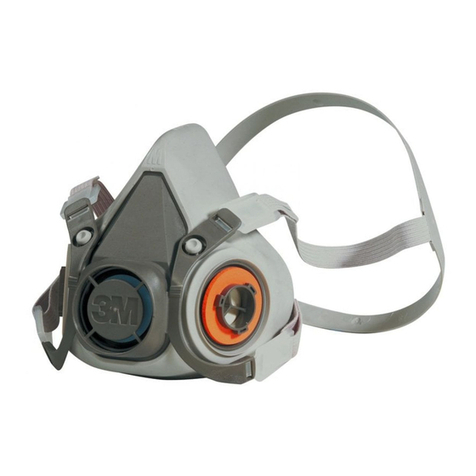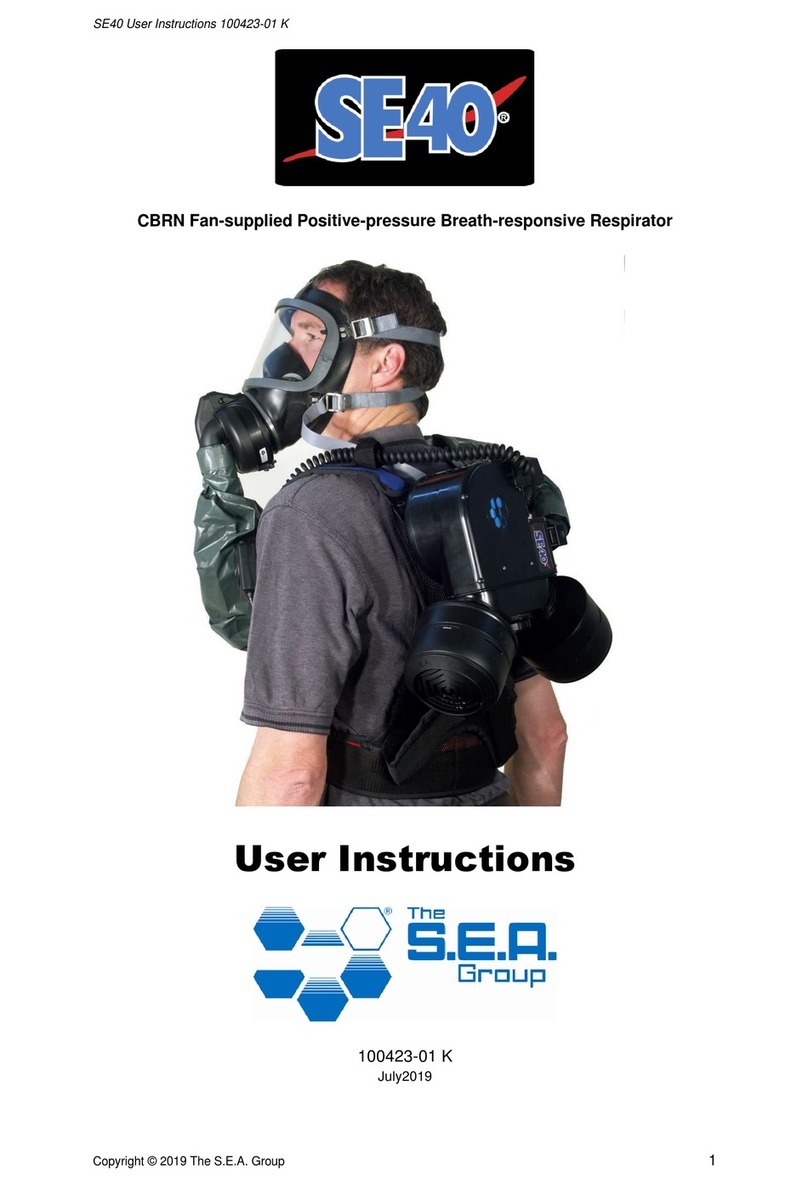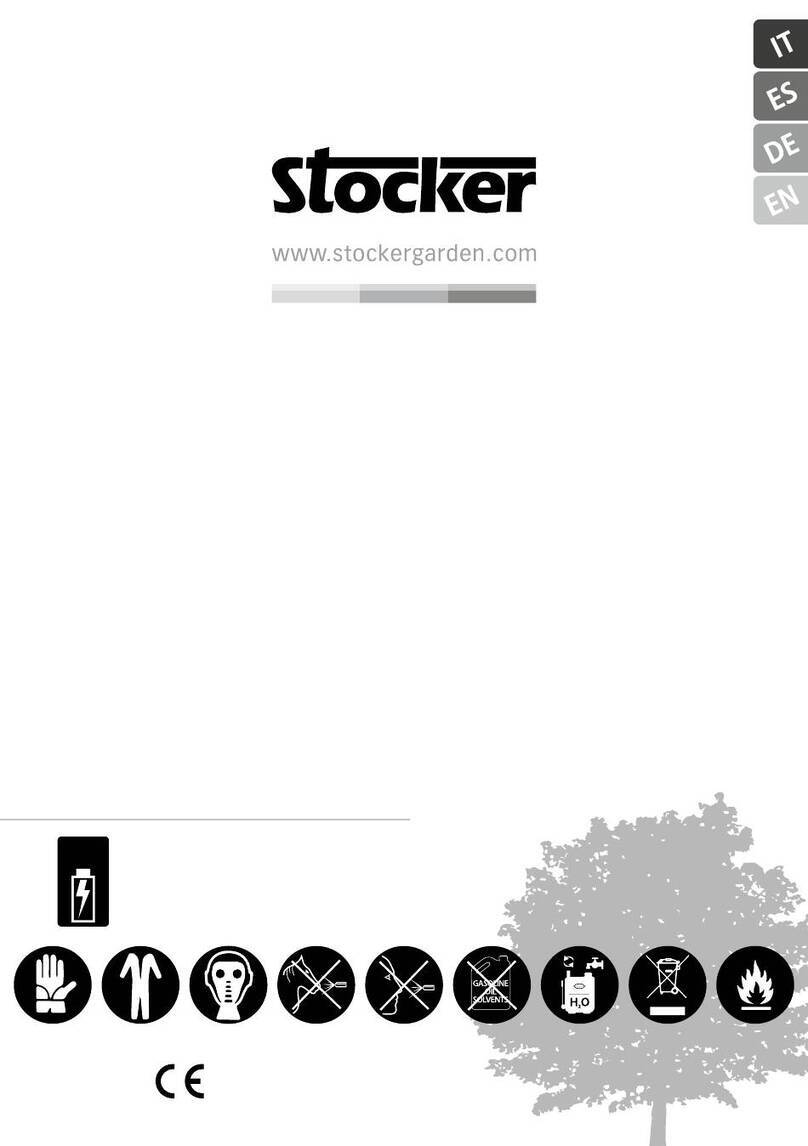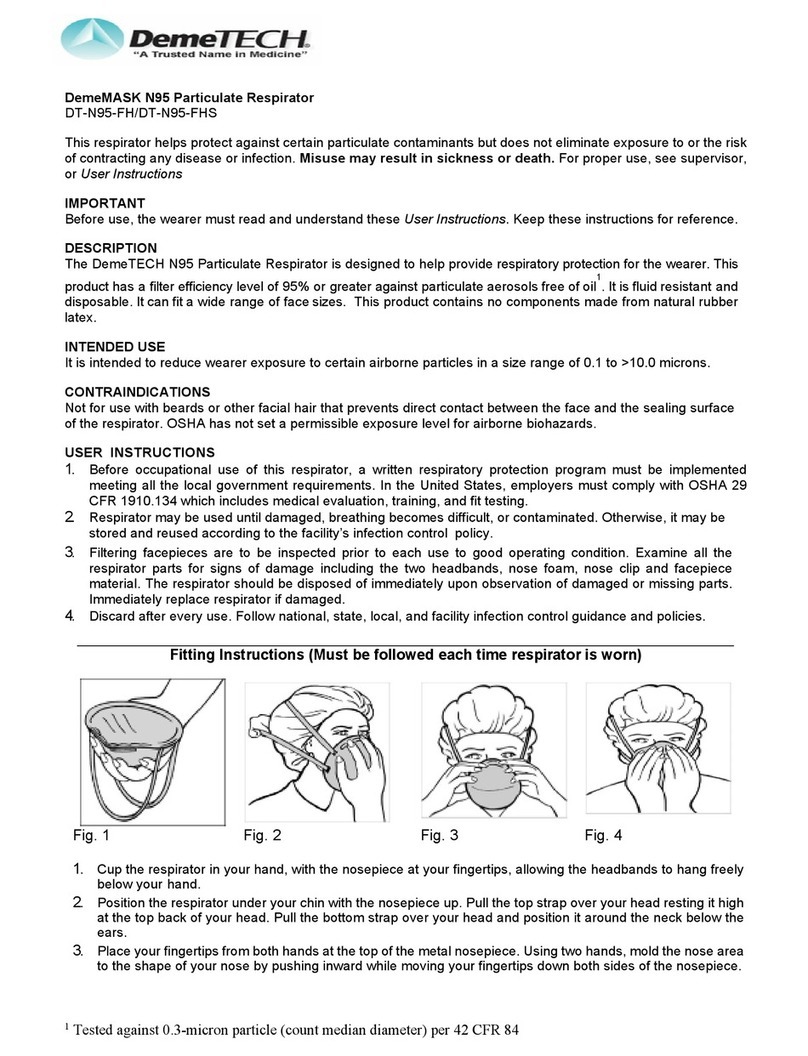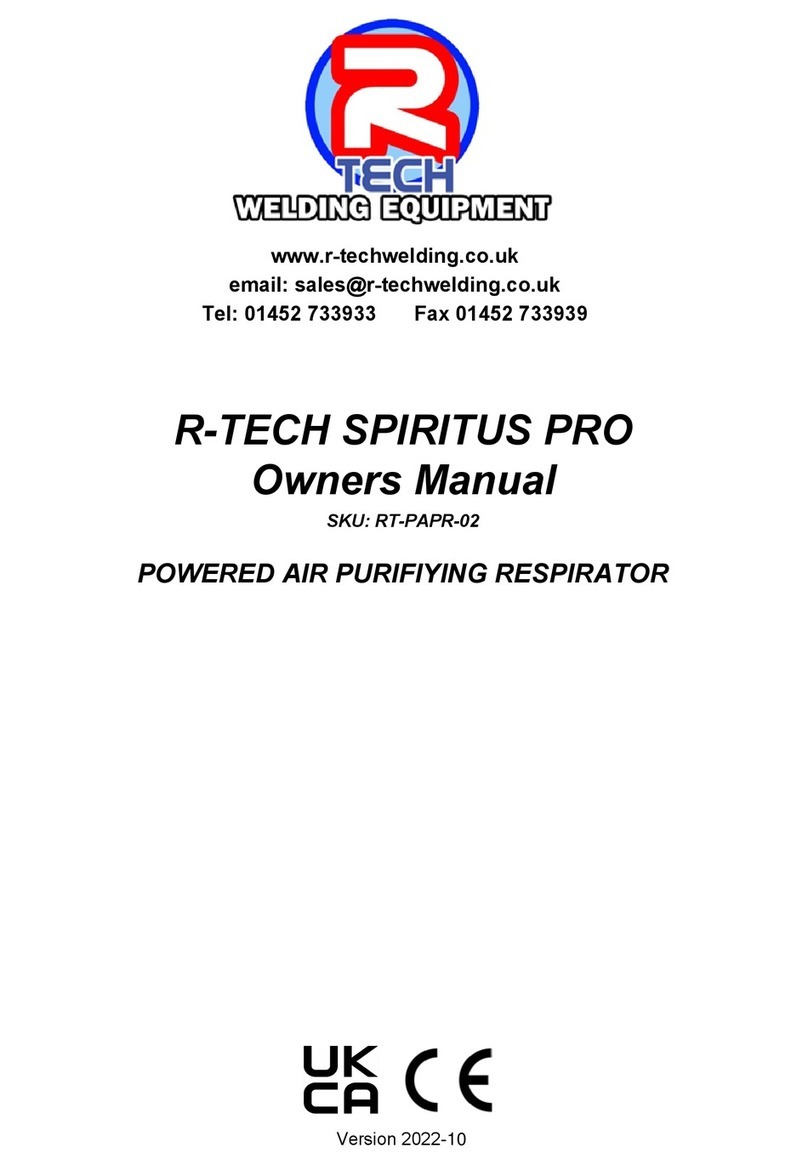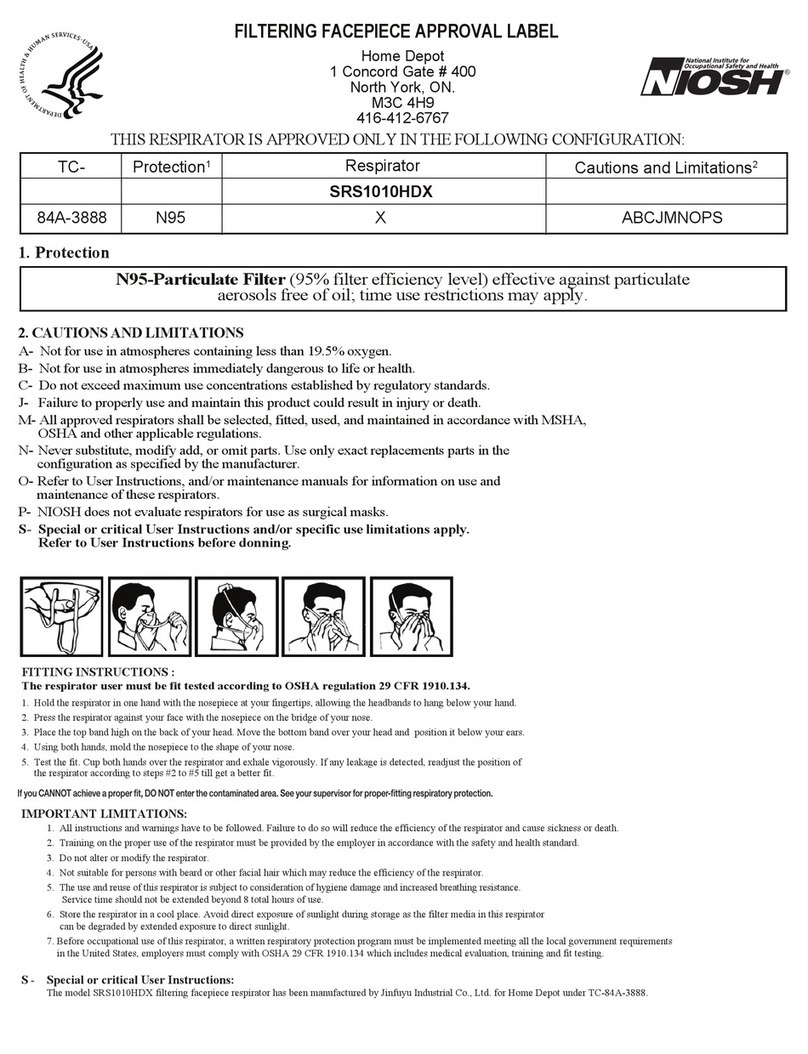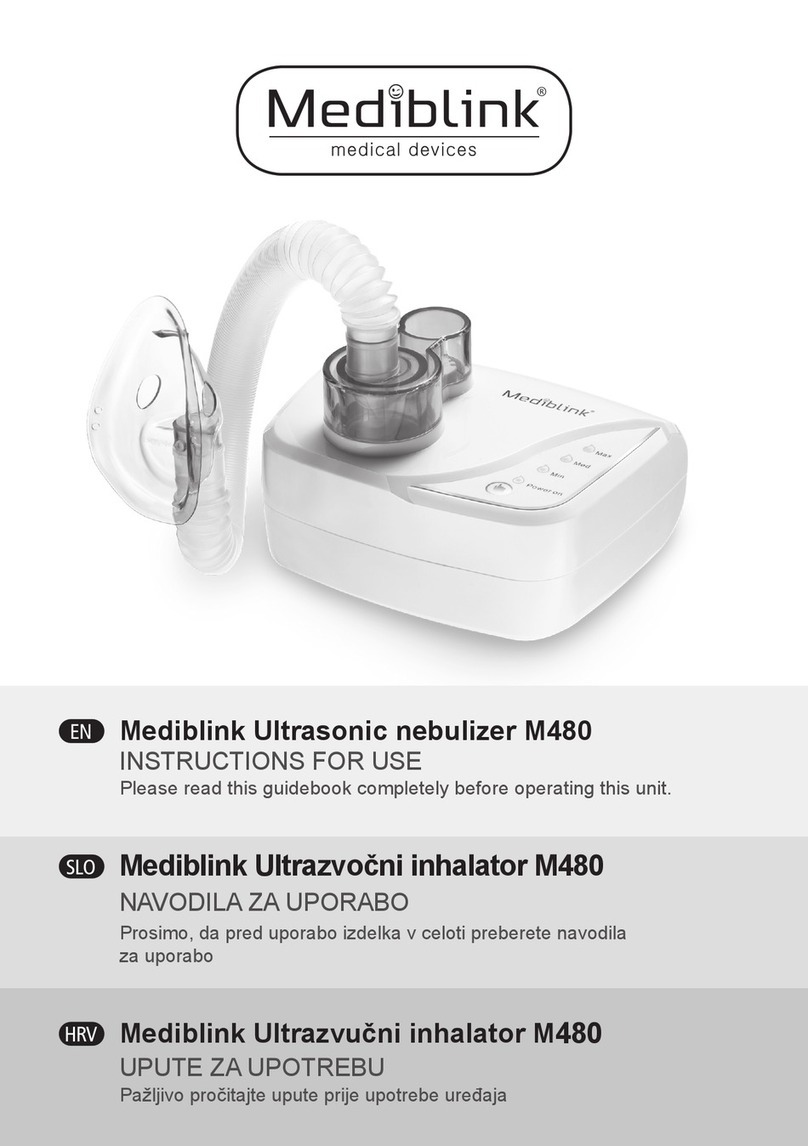BMC REACTHEALTH Luna G3 APAP User manual

User Manual
Luna®G3 APAP / Luna®G3 CPAP
LG3600 / LG3500

Luna®G3 APAP / Luna®G3 CPAP User Manual
Table of Contents
1. Introduction ··························································································· 1
2. Symbols·································································································1
2.1 Control Buttons············································································· 1
2.2 Device Symbols ············································································ 1
3. Warning, Caution and Important Tip ························································ 4
4. Intended Use ························································································· 4
5. Contraindications··················································································· 5
6. Specifications ························································································ 6
7. Available Therapies ················································································ 9
8. Glossary·································································································9
9. Model ·································································································11
10. Package Contents ············································································· 11
11. System Features·················································································· 12
12. First Time Setup ··················································································· 13
12.1 Placing the Device···································································· 13
12.2 Installing the Air Filter and Filter Cap············································ 14
12.3 Connecting to Power ································································ 15
12.4 Assembling the Tubing / Heated Tubing and Mask······················· 16
12.5 Using Oxygen with the Device···················································· 18
12.6 Inserting the SD Card·································································18
12.7 Starting Treatment····································································· 19
13. Routine Use ························································································ 19
13.1 Connecting the Tubing······························································ 19
13.2 Adjusting the Tubing·································································· 20
13.3 Turning on the Airflow ································································ 20
13.4 Heating the Water ···································································· 20
13.5 Using the Ramp Feature ···························································· 20
13.6 Accessing the iCode·································································20
13.7 Turning the Device Off······························································· 21
14. Heated Humidifier··············································································· 21
14.1 Filling the Water Chamber ························································· 21
14.1.1 Removing the Water Chamber········································ 21
14.1.2 Filling Water ··································································· 21
14.1.3 Returning the Water Chamber········································· 22
14.2 Emptying the Water Chamber ··················································· 23
14.3 Setting the Humidity Level·························································· 24
15. Using the Cellular Module···································································· 24
16. Navigating the Patient Menu······························································· 26
16.1 Steps to Navigate the Patient Menu ··········································· 26
16.1.1 Accessing the Main Interface ·········································· 26
16.1.2 Bringing up the Initial Setup Interface ······························· 26
16.1.3 Selecting Options ··························································· 27
16.1.4 Adjusting Options ··························································· 27
16.1.5 Confirming Adjustments ·················································· 28
16.1.6 Turning Pages·································································28
16.1.7 Exiting the Patient Menu·················································· 28
16.2 Options of the Patient Menu and Corresponding Descriptions ······ 29

Luna®G3 APAP / Luna®G3 CPAP User Manual
17. Alert ·································································································· 31
18. Cleaning···························································································· 32
18.1 Cleaning the Water Chamber···················································· 33
18.2 Cleaning the Transfer Box ·························································· 33
18.3 Cleaning the Mask and Headgear ············································· 34
18.4 Cleaning the Enclosure······························································ 34
18.5 Cleaning the Tubing·································································· 34
18.6 Cleaning and Replacing the Air Filter·········································· 36
19. Traveling ···························································································· 37
19.1 Traveling with the Device··························································· 37
19.2 Traveling by airplane·································································37
20. Reordering ························································································· 37
21. Technical Support··············································································· 38
22. Disposal ····························································································· 38
23. Troubleshooting·················································································· 38
23.1 Common Problems in Patients and Corresponding Solutions········· 39
23.2 Common Problems in the Device and Corresponding Solutions ···· 41
24. Information of QoS·············································································· 42
25. EMC Requirements ············································································· 43
26. Limited Warranty ················································································ 49

Luna®G3 APAP / Luna®G3 CPAP User Manual
1 / 49
1. Introduction
Thank you for your purchase of the Luna®G3 APAP / Luna®G3 CPAP. This User
Manual will provide you with information about your device. Please read it carefully.
If you experience any difficulties or problems during use, please contact your
homecare provider or physician.
2. Symbols
2.1 Control Buttons
Home Button
Start / Stop Button
Knob
2.2 Device Symbols
Follow Instructions for Use
Consult instructions for use
Type BF Applied Part (mask)
Class II (Double Insulated)
/
For indoor use only
AC Power
DC Power
IP22
≥ 12.5 mm Diameter, Dripping (15ºtilted)
Hot Surface
Logo of BMC Medical Co., Ltd.
Serial Number

Luna®G3 APAP / Luna®G3 CPAP User Manual
2 / 49
Manufacturer
Date of manufacture
Made in China
Use-by Date
Do not use if package is damaged and consult
instructions for use
Disassembly is prohibited
Maximum water level
Product is intended for use by a single patient only
Batch code
Non-Ionizing Radiation
SD Card
WEEE Marking
Air Inlet
Air Outlet
Caution
MR Unsafe
Complies with RTCA DO-160 section 21, category M.
Medical Device
Prescription only

Luna®G3 APAP / Luna®G3 CPAP User Manual
3 / 49
Catalogue number
Unique device identifier
Model Number
Temperature Limit
Humidity Limit
Atmospheric Pressure Limit

Luna®G3 APAP / Luna®G3 CPAP User Manual
4 / 49
3. Warning, Caution and Important Tip
WARNING!
Indicate the possibility of injury to the user or operator.
CAUTION!
Indicate the possibility of damage to the device.
IMPORTANT TIP!
Indicate the possibility that such operation may affect the effectiveness or ease of
use of the device.
Warnings, Cautions, and Important Tips appear throughout this manual as they
apply.
4. Intended Use
The Luna®G3 APAP / Luna®G3 CPAP is a CPAP (Continuous Positive Airway Pressure)
device designed for the treatment of adult Obstructive Sleep Apnea (OSA). The
integrated humidifier is indicated for the humidification and warming of air from the
flow generator device. These devices are intended for single-patient use by
prescription in the home or hospital/institutional environment on adult patients. It is
to be used on patients > 66 lbs/30 kg for whom CPAP therapy has been prescribed.
WARNINGS!
• This device is intended for adult use only.
• This device is not intended for life support.
• The instructions in this manual are not intended to supersede established medical
protocols.
• To ensure that you receive the safe, effective therapy prescribed for you, use only
REACT HEALTH accessories.
• Do not bring the device or accessories into a Magnetic Resonance (MR)
environment as it may cause unacceptable risk to the patient or damage to the
device or MR medical devices. The device and accessories have not been
evaluated for safety in an MR environment.
• Do not use the device or accessories in an environment with electromagnetic
equipment such as CT scanners, Diathermy, RFID and electromagnetic security
systems (metal detectors) as it may cause unacceptable risk to the patient or
damage to the device. Some electromagnetic sources may not be apparent, if you
notice any unexplained changes in the performance of this device, if it is making
unusual or harsh sounds, disconnect the power cord and discontinue use. Contact
your home care provider.

Luna®G3 APAP / Luna®G3 CPAP User Manual
5 / 49
CAUTIONS!
• U. S. federal law restricts this device to sale by or on the order of a physician.
• The patient is an intended operator.
• The device is intended for use by operators trained or experienced in similar
equipment.
• Cleaning and disinfection can be performed by the patient.
IMPORTANT TIP!
• Read and understand the entire user manual before operating this system. If you
have any questions concerning the use of this system, contact your home care
provider or physician.
5. Contraindications
Studies have shown that the following pre-existing conditions may contraindicate
the use of positive airway pressure therapy for some patients:
Absolute Contraindications: Pneumothorax, mediastinal emphysema; cerebrospinal
fluid leak, traumatic brain injury, or pneumocephalus; shock caused by a variety of
conditions before treatment; active epistaxis; upper gastrointestinal bleeding
before treatment; coma or impaired consciousness making the use of mask during
therapy impossible; giant vocal fold polyp, etc.
Relative Contraindications: Severe coronary heart disease complicated with left
ventricular failure, acute otitis media, excessive respiratory secretions and weak
cough, weak spontaneous breathing, nasal or oral tracheal intubation and
tracheotomy, severe nasal congestion caused by a variety of conditions, lung
bullae, and allergies to breathing masks, etc.
The following side effects may occur during treatment:
- Dryness of the mouth, nose and throat
- Abdominal bloating
- Ear or sinus discomfort
- Eye irritation
- Skin irritation due to the use of a mask
- Chest discomfort
IMPORTANT TIPS!
• An irregular sleep schedule, alcohol consumption, obesity, sleeping pills, or
sedatives may aggravate your symptoms.
• Please use a mask which meets ISO 17510: 2015.
CAUTION!
• Contact your physician if symptoms of sleep apnea recur. Contact your physician
if you have any questions concerning your therapy.

Luna®G3 APAP / Luna®G3 CPAP User Manual
6 / 49
6. Specifications
Device Size
Dimensions (L x W x H): 265 mm × 145 mm × 114 mm
Weight: 1.7 kg
Water capacity: To maximum fill line 360 mL
Product Use, Transport and Storage
Operation Transport and Storage
Temperature: 5°C to 35°C (41˚F to 95˚F) -25°C to 70°C (-13˚F to 158˚F)
Humidity: 15% to 93% Non-condensing 15% to 93% Non-condensing
Atmospheric Pressure: 760 to 1060 cmH2O 760 to 1060 cmH2O
Altitude: Sea level to 2300 m Sea level to 2300 m
Heated Humidifier
Humidifier Settings: Off, Auto, 1 to 5 (95˚F to 154.4˚F / 35°C to 68°C)
Humidifier Output: No less than 15 mg H2O/L
Environmental Conditions: Maximum airflow, 35°C, 15% relative humidity
Maximum Operating Pressure: 40 cmH2O
Pressure Drop with Humidifier: < 0.4 cmH2O at 60 LPM flow
Maximum Delivered Gas Temperature: ≤ 43°C
Mode of Operation
Continuous
Work Mode
LG3600: CPAP, AutoCPAP
LG3500: CPAP
SD Card
The SD card can record patient data and fault information
AC Power Consumption
100 V - 240 V , 50 Hz / 60 Hz, 2 A Max
Device offer to Heated Tubing Communications Port
24 V 18 W
Type of Protection Against Electric Shock
Class II Equipment
Degree of Protection Against Electric Shock
Type BF Applied Part
Degree of Protection Against Ingress of Water
IP22
Pressure Range
4 to 20 cmH2O (in 0.5 cmH2O increments) ≤ 30 cmH2O under single fault conditions.

Luna®G3 APAP / Luna®G3 CPAP User Manual
7 / 49
Static Pressure Stability at 10 cmH2O
±0.5 cmH2O
Dynamic Pressure Stability
Pressures (cmH2O)
10 BPM
15 BPM
20 BPM
6.5
±0.5
±0.5
±0.5
10
±1
±1
±1
20
±1
±1
±1
Device with humidification and 22 mm Tubing or Heated Tubing.
Ramp
The ramp time ranges from 0 to 60 minutes.
The A-weighted sound pressure level and sound power level
When the device is working at the pressure of 10 hPa, its sound pressure level and
sound power level shall not be greater than the values in the following table:
Sound Pressure
Level
Uncertainty
Sound Power
Level
Uncertainty
28 dB(A)
2 dB(A)
36 dB(A)
2 dB(A)
Note: Declared dual-number noise emission values in accordance with ISO
4871:1996.
Maximum Flow
Test Pressures (cmH2O)
4
8
12
16
20
Measured Pressure at the Patient
Connection Port (cmH2O)
3
7
11
15
19
Average Flow at the Patient
Connection Port (L/min)
85
135
140
140
140
When the working pressure is set to the values listed in the table, the average
flow rate at the patient end should be greater than 80% of the corresponding
flow value in the table.
Air Tubing
Air tubing
Length
Inner diameter
Tubing
6 ft. (1.83 m)
19 mm
Heated Tubing
6 ft. (1.83 m)
19 mm
The Form and the Dimensions of the Patient Connection Port
The 22 mm conical air outlet complies with ISO 5356-1.
Air filter
Type
Material
Average arrestance
Standard filter
Polyurethane
> 20% for 10 micron

Luna®G3 APAP / Luna®G3 CPAP User Manual
8 / 49
Cellular Module
Transportation Requirements
Shock, severe vibration, and moisture should be
avoided in transportation
Frequency Bands
Bands12, 3, 4, 5, 8, 12, 13, 20, 28
Communication Mode
LTE Cat M1/ NB1
Effective Radiated Power LTE
LTE Cat M1/ NB1: ≤+23 dBm (2100 mW), Class 3
FCC ID
XPY2AGQN4NNN
Security Measures
Authentication
Enforced on all data channels
(outgoing and incoming)
Encryption
Base 128 encoding
1The LTE bands supported by Cellular Module are defined in above, while the
following Table 1 describes the Transmitting and Receiving frequencies.
Table 1 Transmitting and Receiving frequencies
Parameter
Min.
Max.
Unit
Remarks
Frequency
range FDD
Band 12
(700 MHz)
Uplink
699
716
MHz
Module transmit
Downlink
729
746
MHz
Module receive
Frequency
range FDD
Band 28
(700 MHz)
Uplink
703
748
MHz
Module transmit
Downlink
758
803
MHz
Module receive
Frequency
range FDD
Band 13
(700 MHz)
Uplink
777
787
MHz
Module transmit
Downlink
746
756
MHz
Module receive
Frequency
range FDD
Band 20
(800 MHz)
Uplink
832
862
MHz
Module transmit
Downlink
791
821
MHz
Module receive
Frequency
range FDD
Band 5
(850 MHz)
Uplink
824
849
MHz
Module transmit
Downlink
869
894
MHz
Module receive
Frequency
range FDD
Band 8
(900 MHz)
Uplink
880
915
MHz
Module transmit
Downlink
925
960
MHz
Module receive

Luna®G3 APAP / Luna®G3 CPAP User Manual
9 / 49
Parameter
Min.
Max.
Unit
Remarks
Frequency
range FDD
Band 4
(1700 MHz)
Uplink
1710
1755
MHz
Module transmit
Downlink
2110
2155
MHz
Module receive
Frequency
range FDD
Band 3
(1800 MHz)
Uplink
1710
1785
MHz
Module transmit
Downlink
1805
1880
MHz
Module receive
Frequency
range FDD
Band 2
(1900 MHz)
Uplink
1850
1910
MHz
Module transmit
Downlink
1930
1990
MHz
Module receive
WARNING!
• All other wireless technology emitters must be kept at least 30 cm (12 inches) from
the Cellular Module.
CAUTION!
• Considering the requirements of network security, the CPU on this equipment only
supports the standard of our product software and does not support the operation
of other foreign software.
7. Available Therapies
The device delivers the following therapies:
CPAP –Delivers Continuous Positive Airway Pressure; CPAP maintains a constant
level of pressure throughout the breathing cycle.
AutoCPAP –Delivers CPAP therapy and provides an air pressure no less than the
prescribed pressure based on the patient’s needs.
8. Glossary
Apnea
A condition marked by the cessation of spontaneous breathing.
AutoCPAP
Adjust CPAP pressure automatically to improve patient comfort based on
monitoring of apnea and snoring events.
Auto Off
When this feature is enabled, the device automatically discontinues therapy
whenever the mask is removed.

Luna®G3 APAP / Luna®G3 CPAP User Manual
10 / 49
Auto On
With this feature, the device automatically initiates therapy when you breathe into
the mask. This feature is always enabled.
SmartC
In CPAP mode, if SmartC is set to on, the device can adjust Treat P according to the
patient's respiratory event during a certain time.
SmartA
In AutoCPAP mode, if SmartA is set to on, the device can adjust Initial P and Min
APAP according to the patient's respiratory event during a certain time.
Initial P
Initial pressure.
Min APAP
Minimum Automatic Positive Airway Pressure.
CPAP
Continuous Positive Airway Pressure.
iCode
A feature that is intended to give access to compliance and therapy management
information. The “iCode” consists of six separate codes displayed in the Patient
Menu, each code is a sequence of numbers. The “iCode QR+” display
two-dimensional codes.
LPM
Liters Per Minute.
OSA
Obstructive Sleep Apnea.
Patient Menu
The display mode in which you can change patient-adjustable device settings,
such as the starting pressure for the Ramp feature.
Ramp
A feature that may increase patient comfort when therapy is started. It begins from
a low pressure and then gradually increases to the prescribed setting pressure so
that the patient can fall asleep more comfortably.
Reslex
A therapy feature that is enabled by your physican to provide pressure relief during
exhalation.
Standby State
The state of the device when power is applied but the airflow is turned off.
min
Means the time unit “minute”.

Luna®G3 APAP / Luna®G3 CPAP User Manual
11 / 49
h
Means the time unit “hour”.
yy mm dd / mm dd yy / dd mm yy
Denotes date.
9. Model
Item
No.
Product Description
Work
Mode
Maximum
Work
Pressure
(cmH2O)
Product
Contents
Optional
Accessory
LG3600
Device
(3.5-inch LCD)
Tubing(optional),
Cellular Module
(optional),
Heated Tubing
(optional)
CPAP,
AutoCPAP
20
LG3500
Device
(3.5-inch LCD)
CPAP
10. Package Contents
After unpacking the system, make sure you have everything shown here:
No.
Articles
Qty.
Notes
1
Device
1
2
Air Filter
2
3
Power Adapter
1
4
Power Cord
1
5
Cellular Module
1
Optional
6
Tubing
1
Optional
7
Heated Tubing
1
Optional
8
SD Card
1
Optional
9
Carrying Case
1
10
Accompanying Documents
1
All parts and accessories are natural rubber latex free.
The expected service life of the device is five years from first date of use, if the use,
maintenance, cleaning and disinfection are in strict accordance with the User
Manual. The shelf life of the device is ten years.
The expected service life of the Tubing and the Heated Tubing is six months from first
date of use. The shelf life of the Tubing and the Heated Tubing is 3 years.
The expected service life of the Water Chamber is 6 months from first date of use.
WARNINGS!
• The device should only be used with the mask and accessories manufactured or
recommended by REACT HEALTH or with those recommended by your prescribing

Luna®G3 APAP / Luna®G3 CPAP User Manual
12 / 49
physician. The use of inappropriate masks and accessories may affect the
performance of the device and impair the effectiveness of therapy.
• Do not pile up the long tubing at the head of the bed, as it may wrap around the
head or neck of the patient during sleep.
•Do not connect any equipment to the device unless recommended by REACT
HEALTH or your health care provider.
• Exceeding the Expected Service life, our company cannot guarantee the normal
function of the device, nor the safety and effectiveness of the device.
IMPORTANT TIPS!
• If any of the above parts are missing, contact your home care provider.
• Contact your home care provider for additional information on the available
accessories of this device. When using optional accessories, always follow the
instructions enclosed with the accessories.
11. System Features
Knob
Display Screen
Home Button
Start / Stop Button
Fig. 11-1
Name
Function
Start / Stop Button
Start / Stop delivering air
Display Screen
Display menus for operation, messages, monitoring
data, etc.
Home Button
Return to the previous menu or main interface
Knob
Adjust device settings
Air Outlet
DC Inlet
Filter Cap (Air Inlet)
Heated Tubing Port
Fig. 11-2

Luna®G3 APAP / Luna®G3 CPAP User Manual
13 / 49
Name
Function
Air Outlet
Deliver pressurized air; connect to the tubing
Heated Tubing Port
Connected to the plug of the heated tubing
DC Inlet
An inlet for the DC power supply
Filter Cap (Air Inlet)
Cover and secure the air filter, which is used to filter
dust and pollen in the air entering the device
Transfer Box
SD Card Slot
Fig. 11-3
Name
Function
Transfer Box
For the connection of the device to the water
chamber
SD Card Slot
Insert the SD card into this slot
CAUTION!
• The pictures in this manual are only for reference, if they are different from the
material object, the latter shall prevail.
12. First Time Setup
12.1 Placing the Device
Place the device on a firm, flat surface.
WARNINGS!
• If the device has been dropped or mishandled, if the enclosure is broken, or if
water has entered the enclosure, disconnect the power cord and discontinue use.
Contact your home care provider immediately.
• If the room temperature is warmer than 95°F (35°C), the airflow produced by the
device may exceed 109.4°F (43°C ). The room temperature must be kept below 95°F
(35°C ) while the patient uses the device.
CAUTIONS!
• Always ensure that the device is placed in an area where the screen and
indicators are clearly visible.
• If the device has been exposed to either very hot or very cold temperatures, allow

Luna®G3 APAP / Luna®G3 CPAP User Manual
14 / 49
it to adjust to room temperature (approximately 2 hours) before beginning setup.
• Make sure the device is away from any heating or cooling equipment (e.g.,
forced air vents, radiators, air conditioners).
• The device is not suitable for use in high humidity environments. Make sure that no
water enters the device.
• Make sure that bedding, curtains, or other items are not blocking the filter or vents
of the device.
• Keep pets, pests or children away from the device and avoid small objects being
inhaled or swallowed.
• To avoid explosion, this device must not be used in the presence of flammable
gases (e.g. anesthetics).
•Tobacco smoke may cause tar build-up within the device, leading to the
malfunctioning of the device.
• Air must flow freely around the device for it to work properly.
• Empty the water chamber completely before moving the device.
12.2 Installing the Air Filter and Filter Cap
(1) Attach the air filter to the filter cap, as shown in Fig. 12-1.
Filter Cap
Air Filter
Fig. 12-1
(2) Install the filter cap containing the air filter to the device, as shown in Fig. 12-2.
Fig. 12-2
WARNINGS!
• Do not block the gas INTAKE PORT, thereby interfering with the therapy.
• Nebulization or humidification can increase the resistance of breathing system
filters and the operator must monitor the breathing system filter frequently for
increased resistance and blockage to ensure the delivery of the therapeutic
pressure.

Luna®G3 APAP / Luna®G3 CPAP User Manual
15 / 49
•Please change the Air Filter regularly and don't block it; Fire, open ignition source
and smoking prohibited. (Refer to 18.6 Replacing the Air Filter)
CAUTIONS!
• The air filter must be in place when the device is operating.
• Device must be unplugged when installing the air filter and filter cap.
12.3 Connecting to Power
(1) Insert the plug of the power adapter into the DC Inlet on the back of the device.
(2) Connect the power cord to the power adapter.
(3) Plug the other end of the power cord into the power outlet.
Power Adapter
Power Cord
DC Inlet
Fig. 12-3
Note: The length of the power cord and power adapter is 1.5 m and 1.8 m
respectively without the function of preventing electromagnetic interference.
WARNINGS!
• The device is powered on for use when the power cord and power adapter is
connected. The Knob turns the blower On / Off.
• Use of the device at an AC voltage beyond the stated range (see Section 6 “AC
Power Consumption”) may damage the device or cause device failure.
• Connect to appropriate power for proper operation of the device.
• Inspect the power cord often for any signs of damage. Replace a damaged cord
immediately.
IMPORTANT TIPS!
• After interruption and restoration of the power supply, the device will restore its
pre-interruption working status automatically.
• To remove AC power, disconnect the power cord from the power outlet.

Luna®G3 APAP / Luna®G3 CPAP User Manual
16 / 49
12.4 Assembling the Tubing / Heated Tubing and Mask
(1) Connect one end of the tubing to the air outlet of the device, as shown in Fig.
12-4.
Air Outlet
Tubing
Fig. 12-4
(2) Connect the heated tubing joint to the air outlet of the device, and then insert
the power plug of the heated tubing into the heated tubing port on the back of the
device, as shown in Fig. 12-5.
Power Plug
Heated Tubing
Air Outlet Heated Tubing Port
Heated Tubing Joint
Fig. 12-5
CAUTION!
• As the ambient temperature decreases, the humidifier can be reduced to
improve or avoid condensation in the pipeline. If the ambient temperature is too
low, in order to avoid condensation, it is recommended to use the heated tubing.
If the heated tubing is connected correctly, the icon will become a number in
the Main Interface on the screen of the device, as shown in Fig. 12-6.

Luna®G3 APAP / Luna®G3 CPAP User Manual
17 / 49
Fig. 12-6
Turn the Knob to turn on or turn off the heated tubing and to adjust the heat
level according to instructions of the Patient Menu of the device.
There are five heat levels available, and the number of heat level will appear in the
Main Interface on the screen of the device. The number 3 next to the icon
indicating the heat is adjusted to Level 3, as shown in Fig. 12-7.
Fig. 12-7
(3) Connect the other end of the tubing to the mask according to the user manual
for the mask.
WARNINGS!
• If you are using a mask with a built-in exhalation port, connect the mask’s
connector to the tubing.
• If you are using a mask with a separate exhalation port, connect the tubing to the
exhalation port. Position the exhalation port so that the vented air is blowing away
from your face. Connect the mask’s connector to the exhalation port.
•If you are using a full-face mask (a mask covering both your mouth and nose), the
mask must be equipped with a safety (entrainment) valve.
• In order to minimize the risk of CO2rebreathing, the patient should observe the
following instructions:
- Use only tubing and mask provided by REACT HEALTH.
- Do not wear the mask for more than a few minutes while the device is not
operating.
- Use only masks with vent holes. Do not block or try to seal the vent holes in the
This manual suits for next models
3
Table of contents
Other BMC Respiratory Product manuals

